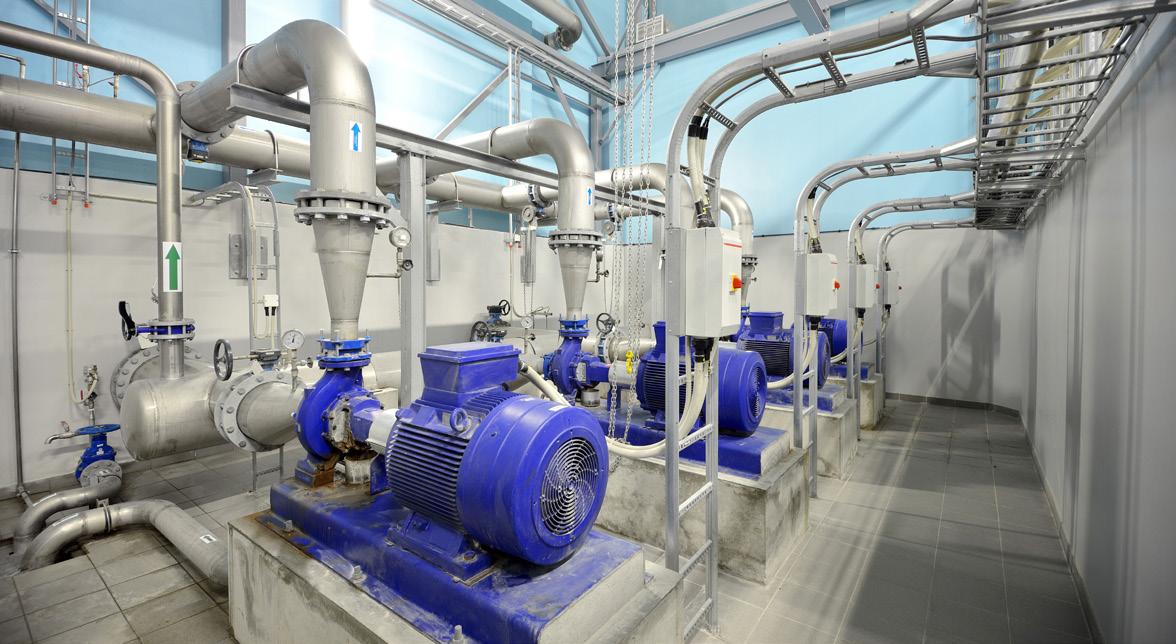
3 minute read
Q&A
In this issue of flow, Tony Keville, Managing Director of pump specialist, Tomlinson Hall, answers readers’ pump related questions.
QUESTION: Our water system runs on a constant pressure booster set, with a Variable Speed Drive (VSD), and has operated satisfactorily for several years. However, we have recently fitted air actuated ball and butterfly valves and the system is constantly tripping on over pressure activations. What might be causing this, and are there any solutions we could try?
TONY KEVILLE: The actual closure time for ball and butterfly valves only takes place over the last 15 to 25 degrees and hence is very short. If you consider the line constant and use the simplified Joucowsky equations you will find that the surge pressures that are being generated may be as much as 30 bar, or even higher, and so will trip the transducers whose response time is very short.
You could try and fit signal processing to ensure that the overpressure has to be present for at least 500ms before the VSDs respond. You may also try and fit all air actuated valves with snubbers to increase their actuation time, preferably to several seconds.

QUESTION: We pump from a large storage tank to various demand points in our factory using an air driven diaphragm pump. The valves for each demand point are air driven ball valves controlled by level controllers in the reactors. The pipework runs at a high level through the roof space which can be warm. Recently, we have experienced some issues with the discharge valves being jammed in the seats and cannot explain why. Is there something wrong with the pump?
TONY KEVILLE: The pump is perfectly OK, as is the system concept, the execution needs some attention though. The supply tank has a large thermal mass so it takes a long time to both heat up and cool down. The pipework has a small volume and is easily heated up.
When the demand valve is opened the pump starts automatically and supplies liquid to the demand point, that valve now closes and the pump stalls out as a hydraulic balance is achieved. So far, so good. But the liquid in the pipework can now heat up and consequently expand. However, as the pipework is a sealed container, due to the pump non-return valve and the closed valve at the demand point, where can the excess liquid go? Frequently on air-operated diaphragm pumps it pushes the discharge valve balls back down and through the valve seats. I have seen this many, many times.
The solution is very simple. You could fit a hydraulic expansion vessel to accommodate the expanded volume, but an easier option is to fit a small relief valve from the discharge to the suction pipework set at 1 bar above air pressure. It only needs to be a ¼ inch valve just don’t forget to add it to your relief valve register.
QUESTION: Our boiler feed pumps have a minimum pressure marked on the discharge pressure gauge, but our demand has dropped significantly, and we want to run them at a lower speed on a ariable Speed Drive (VSD).
TONY KEVILLE: As boiler feed sizes increase the method of taking out the axial thrust changes. Small pumps use the motor bearings either with deep groove bearings or axial thrust bearings. However, as the pumps get larger the use of rolling element thrust bearings tends to give way to using balance discs or drums at the discharge end of the pump, with a low-pressure balance pipe leading back to the suction. If you then proceed to lower the discharge pressure the forces acting between the balance disc and its seating, or along the length of the balance drum, are too low and clashing occurs resulting in a very rapid destruction of the pump. The typical gap on a balance disc is only 12 thousandths of an inch, so you have little leeway for error.
On some larger boiler feed and similar highpressure pumps, and also on large borehole pumps which use a Michell Thrust type bearing, the temptation to use a VSD to save energy is persuasive. However, be very careful as the speed may reach a point at which the tilting pads no longer entrain sufficient lubricant to give adequate cushioning and the bearing can fail very rapidly.
Of course, you should always seek guidance from the pump manufacturer.
To pose your questions, or to see more technical solutions to pump user’s challenges and engage in their discussion, head over to the BPMA’s new online technical forum.
Go to forum.bpma.org.uk or scan the QR code.











